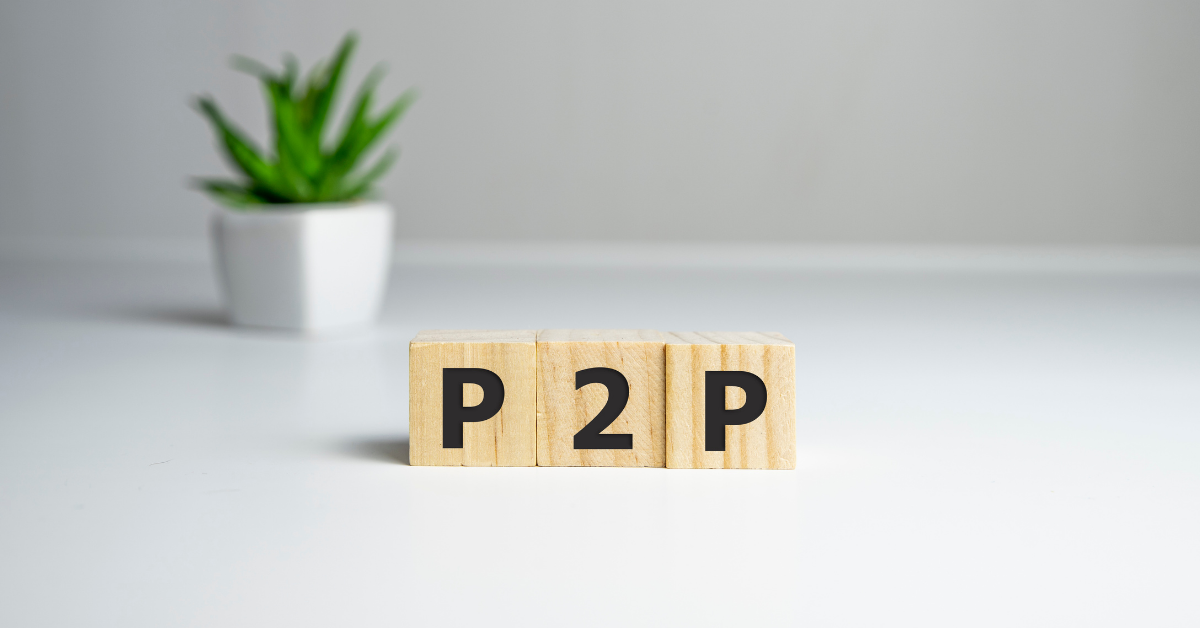22 Apr, 21
Decentralised P2P: Bitcoin’s most important feature

Cryptocurrencies such as bitcoin have evolved dramatically over the past decade, both in technology and overall adoption. New opportunities to trade, store and utilise assets have taken the market to unforeseen levels of utility and popularity. Yet, regardless of how far the market develops, one feature of the biggest cryptocurrencies will remain the most relevant one; being decentralised peer-to-peer (P2P) assets.
In this article, we cover what P2P is, how it works in blockchain networks, the everyday-life advantages, the future perspective and why it is, and always will be, one of the most crucial features of bitcoin and any widely adopted crypto asset.
What is P2P?
Peer-to-peer, or P2P, is a network label to categorise systems where a computer that takes part in the network functions as both client and server. P2P networks don’t require a central server to store and retransmit information. Some examples of P2P that precede Blockchain networks are torrent downloads and the music file-sharing software Napster. Created in 1999 and used primarily for downloading and sharing music, Napster allowed users to transfer data directly from one computer to the other, where Napster was merely an access point to conduct the file transfers instead of a central database.
With software such as Napster, however, users could perform P2P transfers while keeping their original file in their computer and duplicating the content as they wished. For decentralised P2P bitcoin or other cryptos, the biggest challenge was to certify that the original asset would no longer exist in the sender’s database, a task accomplished with the bitcoin Blockchain.
Repurposed for cryptocurrencies under a new P2P network, the Blockchain’s database is shared between computers that partake in its activity. Every transaction in a decentralised blockchain is verified through a chain of data blocks confirmed autonomously by individual computers in the shared network, making each transfer irreversible and incorruptible.
The lack of a central entity to oversee transactions makes decentralised peer-to-peer models stand out from traditional financial systems. Without an intermediary agent, it gives users access to seamless models of finance and data transfers, where transactions only rely on the authenticity and availability of each party involved. In practice, P2P transactions can handle much larger flows at lower fees, while exposing users to several options through different assets and expanding financial access in developing nations.
The practical advantages of P2P
From an everyday-life standpoint, decentralised P2P networks make transactions more accessible, portable and under the complete control of their users. When travelling to areas with different currencies, one can transfer funds from their digital wallet to a device of preference. Once assets are accessible through their mobile phone, desktop or other digital wallets, for instance, users may transact or swap assets as they wish without the hassle of expensive currency exchanges or long banking transfers that take days to execute.
Speaking of expensive transfers, P2P networks such as the bitcoin Blockchain are pretty cost-effective. Users can transfer any amount they wish under lower fees for large transfers, in comparison with commercial banking. Although fees in blockchain networks vary quite often and are pricey at times, cases like these are rare but not that exceptional and show the practicality of transacting vast sums in peer-to-peer protocol. Costs aside, the bureaucracy involved for large international transactions in commercial banking is notoriously overwhelming, and many structural complications come up when remitting money overseas into different assets. With bitcoin, its blockchain relies only on the autonomously verifiable consent of the parties involved, with multiple digital asset rails available globally. Blockchains are still far from ideal, though, with scaling solutions such as Optimism and Ethereum’s 2.0 update constantly at play to make decentralised networks more efficient and functioning at much lower costs.
One of the essential benefits of P2P networks has been social, with applications taking banking and financial information to developing nations and continents. One of the best examples is M-Pesa, a peer-to-peer payment system in Africa bringing simple mobile banking to the previously unbanked. M-Pesa is supported by over 40 million users in Kenya, Tanzania, Congo, Egypt, among others. Although it’s a centralised system owned by Vodafone, M-Pesa shows how simpler banking can assist developing populations to grow and prosper in finance, which a fully decentralised system can only broaden. Our article “The Benefits of Crypto Integration in Africa” covers more examples and applications that P2P finance is taking in the continent, focusing on cryptocurrencies.
Why is P2P still the most important bitcoin feature?
In a nutshell, because it is one of the core foundations of bitcoin. Released in 2009 as a hedge solution against economic turmoil such as the GFC, the Bitcoin whitepaper describes the network as a decentralised “peer-to-peer electronic cash system,” where money can be transferred without relying on trust or approval of a third party overseer. To this day, approximately 633 million Blockchain transactions have been made, and not a single one has failed or been lost due to technical problems. Given their unprecedented features as decentralised financial assets, bitcoin and alternative cryptos would not have gained such massive popularity because, without P2P, users lack the option to utilise and trade assets on their own terms through networks that best fit their needs and interests.
More importantly, decentralised peer-to-peer cryptos allow users to navigate through different monetary policies in digital assets and choose which ones they want to subscribe to according to their financial needs, personal goals and market beliefs. With cryptocurrencies, users vote with their money; the most utilised assets democratically earn more popularity; bitcoin as a deflationary store of value and ethereum as a centrepoint for smart contracts and DeFi, for instance. Whether adopters want a simple hedge against crisis, fiat-backed digitisation or community-built assets for yield and leveraging, P2P decentralisation gives people the power to store and trade the assets that they want to, beyond the fiat they transact on a day to day basis.
Crypto and P2P adoption – The future perspective
From a peer-to-peer standpoint, bitcoin and other cryptocurrencies will continue to grow in adoption as a hedge of financial autonomy as society becomes increasingly cashless. Crypto assets allow users to trade and store value outside of an enclosed system once physical cash is no longer in circulation. As we discussed in our article about economies going cashless, governments are opting for more digital frameworks and central bank digital currencies are a recurring topic of discussion. The decentralised features of cryptocurrencies allow the world to interact in a faster P2P manner than cash while promoting further evolution of peer-to-peer technologies.
Institutions are also seeing the effects of finance digitisation in the market, as institutional adoption was one of the two main influences for the rise in cryptocurrency use for the past year alongside economic uncertainty and fiat devaluation resulting from the Covid-19 crisis. While governments printed fiat to prevent imminent collapse, crypto’s deflationary groundstone pushed peer-to-peer adoption to new heights, functioning as a hedge against market turmoil.
Through the rise in market infrastructure, the past year has seen substantial growth in adoption from well-established traditional names in finance. The entrance into the crypto landscape has been fast and efficient, precisely what characterises blockchain networks. The consistent rise of institutional use and other technologies developed through digital assets, such as DeFi and NFTs, is solid evidence that the market is getting larger and more relevant, with new and efficient applications set to make their entrance in the foreseeable future.
Conclusion
Cryptocurrencies have experienced immense development over the past decade, improving their applications in all fronts of technology, practical use, security and adoption. As new sectors emerge and provide users with ever-growing opportunities, the peer-to-peer feature remains a key reason why decentralised finance has experienced exponential growth. The ability to transact seamlessly without intermediary agents is what made cryptocurrencies like bitcoin groundbreaking in the first place; putting assets in the full management of their proprietors. As adoption grows and financial digitisation becomes the norm, the need for P2P networks will only rise and with it, more investment opportunities.
About Us
Zerocap provides digital asset investment and custodial services to forward-thinking investors and institutions globally. Our investment team and Wealth Platform offer frictionless access to digital assets with industry-leading security. To learn more, contact the team at [email protected] or visit our website www.zerocap.com
FAQs
What is Peer-to-Peer (P2P) in the Context of Cryptocurrencies?
Peer-to-peer (P2P) in the context of cryptocurrencies refers to a network where a computer that participates in the network functions as both a client and a server. P2P networks do not require a central server to store and retransmit information. In the case of cryptocurrencies like Bitcoin, the blockchain’s database is shared between computers that partake in its activity, making each transfer irreversible and incorruptible.
What are the Practical Advantages of P2P Networks in Cryptocurrencies?
P2P networks in cryptocurrencies make transactions more accessible, portable, and under the complete control of their users. They allow users to transact or swap assets as they wish without the hassle of expensive currency exchanges or long banking transfers. They also offer lower fees for large transfers compared to commercial banking. Additionally, P2P networks have social benefits, bringing simple mobile banking to the previously unbanked populations in developing nations.
Why is P2P Considered the Most Important Feature of Bitcoin?
P2P is considered the most important feature of Bitcoin because it is one of the core foundations of the cryptocurrency. Bitcoin was described in its whitepaper as a decentralised “peer-to-peer electronic cash system,” where money can be transferred without relying on trust or approval of a third-party overseer. This feature allows users to utilise and trade assets on their own terms through networks that best fit their needs and interests.
How Does P2P Contribute to the Future of Cryptocurrencies and Digital Finance?
As society becomes increasingly cashless, P2P networks in cryptocurrencies will continue to grow in adoption as a hedge of financial autonomy. Crypto assets allow users to trade and store value outside of an enclosed system once physical cash is no longer in circulation. Institutions are also seeing the effects of finance digitisation in the market, with institutional adoption being one of the main influences for the rise in cryptocurrency use.
What Role Does P2P Play in the Adoption of Cryptocurrencies in Developing Nations?
P2P networks have played a significant role in bringing simple mobile banking to the previously unbanked populations in developing nations. For instance, M-Pesa, a P2P payment system in Africa, has brought mobile banking to over 40 million users in Kenya, Tanzania, Congo, Egypt, among others. While M-Pesa is a centralised system, it shows how simpler banking can assist developing populations to grow and prosper in finance, which a fully decentralised system can only broaden.
Like this article? Share
Latest Insights
Ethereum Smart Contracts: How They Changed Crypto
Ethereum, launched in 2015, revolutionized the digital world by introducing “smart contracts,” self-executing contracts with the terms of the agreement directly written into code. This
Main Crypto Events in the World
The world of cryptocurrencies is dynamic and ever-evolving, with numerous conferences and events held globally to foster innovation, collaboration, and networking among crypto enthusiasts. Here’s
What is Ethena Finance?
Ethena Finance (ENA/USDe) is emerging as a notable player in the cryptocurrency and decentralized finance (DeFi) sectors. Powered by its proprietary stablecoin, USDe, Ethena aims
Receive Our Insights
Subscribe to receive our publications in newsletter format — the best way to stay informed about crypto asset market trends and topics.



 Share
Share  Tweet
Tweet  Post
Post 